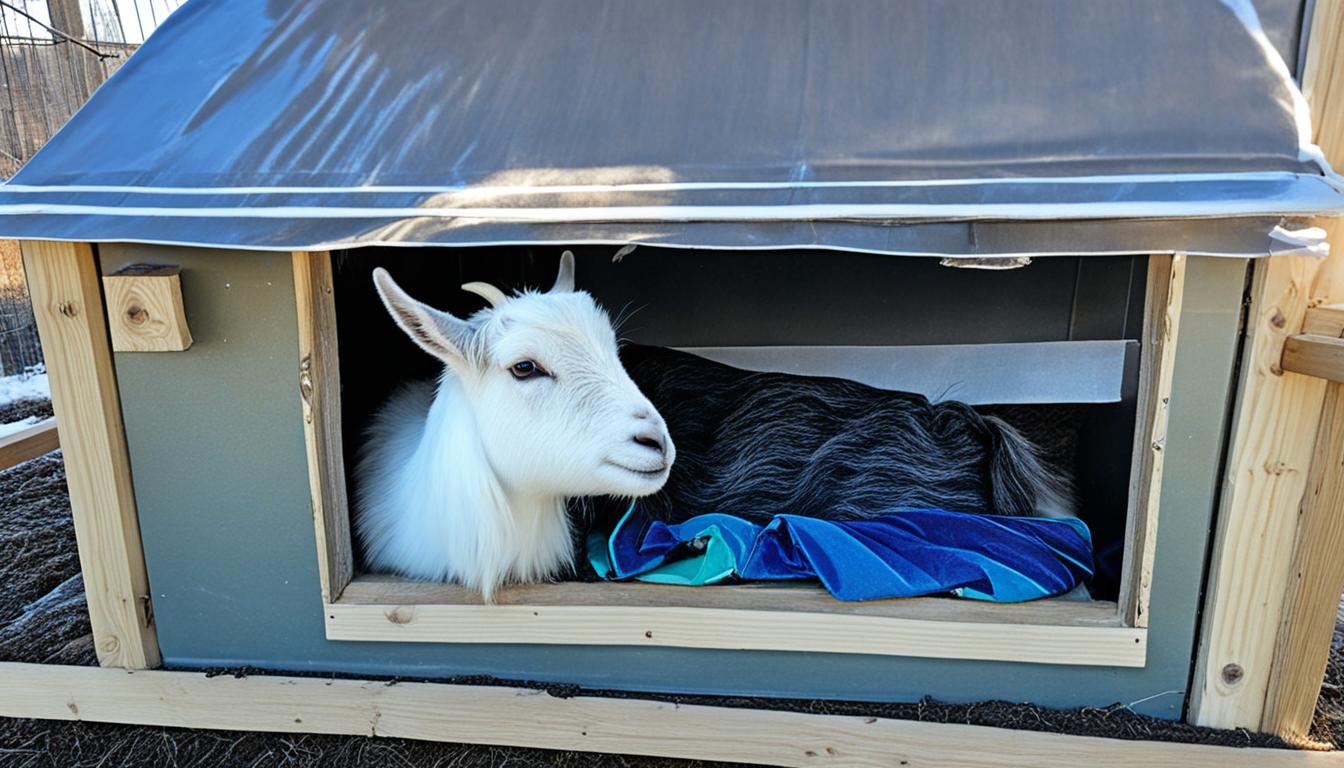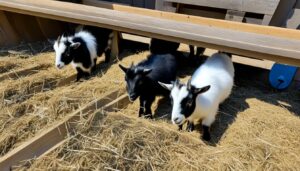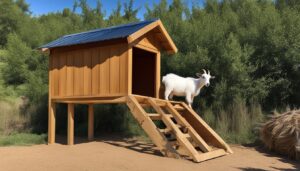When the first snowflakes fall, my mind turns to my pygmy goats in their warm shelter. They love cooler weather but need extra care when it gets too cold. It’s important to make sure their house is snug and good for them before winter arrives.
Pygmy goats, like all goats, have a favorite temperature range that’s just right for them. This range is called their “thermal neutral zone.” For pygmy goats, it’s normally between 54 to 75°F. Some say it might be a bit cooler, from 50 to 68 degrees. If it gets colder than 32°F, they need help to stay warm.
In winter, things like wind, rain, and ice can make it feel colder than it is. This means pygmy goats may need more care before it’s freezing out. As winter comes, I have to make sure their shelter is strong, they have extra food, and there’s good heating. This keeps them happy and snug all winter.
Key Takeaways
- Pygmy goats have a thermal neutral zone preference between 54 to 75°F, or 50 to 68°F according to some sources.
- The lower critical temperature for pygmy goats is 32°F, but this can rise to 58°F if their coat is wet.
- Factors like winter winds, rain, and ice can raise the cold stress threshold for pygmy goats.
- Providing adequate shelter, extra feed, and reliable heating sources is crucial to keep pygmy goats comfortable in cold weather.
- Monitoring water sources and ensuring they don’t freeze over is also an important part of winter goat care.
Understanding Goats’ Thermal Neutral Zone
It’s vital for goats to stay in the right temperature range to be healthy. Just like all livestock, goats have a favorite outdoor temperature. This is the one where they don’t need to use extra energy to stay warm or cool. We call this range the thermal neutral zone.
What is a Thermal Neutral Zone?
The thermal neutral zone is where goats or any animal can keep their body temperature steady with little extra effort. It’s the perfect temperature range for them. In this range, goats don’t have to try so hard to keep from getting too hot or cold.
Goats’ Preferred Temperature Range
For goats, their perfect temperature range is usually between 54 and 75°F. Some say it can be as low as 50 or as high as 68 degrees. Goats can handle it when it’s below 32°F, but only if their fur is dry. Wet fur changes things, making the lowest comfortable temperature 58 degrees.
Winter weather like wind, rain, and ice can make it too cold for goats. They’ll need their owners to help keep them warm. This help is needed before it even gets to freezing.
Providing Adequate Shelter
Your goats should have a strong, winter-safe shelter as the weather gets colder. The goat shelter requirements change based on the goat’s gender. Ewes need 12 to 15 square feet, but rams require more space, 15 to 20 square feet each.
Shelter Requirements for Goats
It’s smart to put your goat shelter on higher ground to avoid floods. A three-sided shelter that faces south is great. It protects them from the north wind but still lets in fresh air. You don’t need to lead the goats inside; they’ll go when they feel cold.
Ventilation and Draft-Free Shelters
Good goat shelter design includes plenty of ventilation. It should also be free from drafts. A draft-free shelter keeps the right temperature for your goats. This keeps them happy during winter.

Ideal Bedding for Winter
To keep goats warm, use a deep layer of straw or grass hay for them to cuddle in. Straw is warmer than pine shavings and acts as a better ground insulator. This deep bedding method requires adding fresh straw on top. It’s a great way to keep goats snug in winter.
Benefits of Straw Bedding
Straw is perfect for goat bedding for winter. It’s better at keeping goats warm than pine shavings because its structure traps air. This insulating layer keeps their core temperature safe in very cold weather.
Deep Bedding Technique
Using a deep bedding technique means adding fresh straw on top regularly. This keeps the environment warm, dry, and cozy for goats. It prevents their body heat from escaping to the cold ground. But remember, keeping the bedding in good condition is key to avoid health problems.
Supplemental Heating Options
When it gets cold, your goats might need extra warmth. This is especially true for young ones who can’t keep themselves warm yet. Luckily, there are many ways to make sure your goats are snug during winter.
Heat Lamps for Goat Shelters
Heat lamps are great for keeping goat shelters warm. The Prima Heat Lamp from Premier1 Supplies is a good option. It’s strong and has a cord that goats won’t chew on, which makes it safe for your goat shelter.
Carbon Fiber Heaters
Carbon fiber heaters produce a lot of heat and can warm a big space. They are small, use little energy, and direct heat right where it’s needed.
Warming Areas for Kids
Baby goats need special places to warm up. You can use things like barrels, crates, or dog igloos as warm spots for them. Heating mats, made for young goats, create a large warm area for them to sleep.

Safety Considerations for Heating
If I think my goats need extra warmth, staying safe matters most. It’s vital to set up heat devices right and pick the best spot for them. This keeps my goats safe and my barn from catching fire.
Proper Installation and Placement
Hang heat lamps high, at least 20 inches up, to be safe. Don’t hang them by the cord to avoid damage and fires. Use strong chains or hooks to keep lamps steady.
Fire Prevention Measures
For lamps with open bulbs, cover them with wire to stop them touching anything flammable. It’s wise to put sand under the lamps instead of shavings to lower the fire risk. Check the cords and bulbs often for any signs of wear. Keep cords away from goats, so they can’t chew them.

What’s the Ideal Temperature Range for a Pygmy Goat House?
Pygmy goats are tough and can take the cold well if they’re dry and protected from the wind. They can handle temperatures as low as 15 below zero Fahrenheit without too much trouble. However, baby goats are more sensitive to the cold.
Goats’ Temperature Tolerance
Baby goats, or kids, struggle to keep warm. They can’t control their body heat as well and need a bit more care. For the first few weeks, they may need to be dried off more after birth. They might also need extra bedding or a warm spot to sleep.
When it gets really cold, like in the single digits Fahrenheit, these extra measures become crucial. A heat lamp or a special warm area can be a lifesaver for them.
Protecting Newborn Kids
Pygmy goats can manage just fine in extreme cold, down to 15 below zero Fahrenheit. But, as I mentioned, young goats are more fragile. They can’t keep themselves as warm and have less energy.
For the first few weeks, they may need special care. This can include more drying off, extra bedding, or a warm place to sleep. If it gets really, really cold, a heat lamp or a warm area is essential to keep them safe.

Water Sources in Cold Weather
As it gets colder, checking your goats’ water is crucial.
Make sure their water doesn’t freeze. Check it twice daily. Using heated water buckets or tanks can help a lot. This stops goat water from freezing in winter.
Preventing Frozen Water Buckets
In freezing temps, water buckets can turn to ice. Goats then have trouble drinking. This can make them dehydrated. Heated buckets or tanks make sure they always have access to water in cold weather. They have a heating system to give goats warm water and avoid freezing.
Benefits of Warm Water
Giving goats warm water is good for their health. Cold water can hurt their stomachs in winter. Heated water once or twice daily helps. It encourages more drinking. This supports their digestion and keeps goats hydrated in the winter.

Goats’ Coat and Body Condition
Cashmere Undercoat
Goats have smart ways to stay warm in cold weather. One way is through their hair coat. They have a soft undercoat of cashmere that acts like a warm blanket.
Their outer coat, made of guard hairs, keeps them dry and clean. These guard hairs can be lifted to trap warm air close to the body. This ability makes their coat look fuller, keeping them even warmer.
Importance of Body Condition
A goat’s muscle condition is key for staying warm. Muscles help by conducting heat better than fat. If a goat is thin or weak, it will feel the cold more. It’s important for goats to be in good shape to handle the cold well.
FAQ
What is a Thermal Neutral Zone?
All livestock have a perfect outdoor temperature range. It doesn’t make them use a lot of energy to stay warm. This range is called the “thermal neutral zone” (or a thermoneutral zone).
What is the typical temperature range for goats’ thermal neutral zone?
For goats, the best temperature range is between 54 to 75°F. Some sources say it’s a bit cooler, from 50 to 68 degrees.
What is the lower critical temperature for goats?
The lowest temperature goats can handle is 32°F. If their coat is wet, they won’t manage well below 58 degrees. Winter winds, rain, and ice make things colder faster, so goats need help staying warm.
What are the shelter requirements for goats?
Ewes need 12 to 15 square feet of shelter each, and rams need 15 to 20 square feet. A good shelter opens south to avoid cold northerly winds and provides plenty of ventilation.
Why is straw a better bedding option for goats in the winter?
Straw is warmer than pine shavings and keeps goats off the cold ground. Adding fresh straw on top of old bedding helps keep goats warm in winter.
What are some supplemental heating options for goat shelters?
Heat lamps, carbon fiber heaters, and shelters made from recycled barrels or crates can offer extra warmth. These are good, especially for young goats who can’t keep themselves warm yet.
What safety considerations are important when using supplemental heating?
Hang heat lamps at least twenty inches away from the ground and walls. Avoid hanging them directly by the cord. Use wire covers to protect against fires. Check the cords, wiring, and bulbs regularly for any damage.
How well can goats tolerate cold temperatures?
Goats can handle very cold weather, even below freezing, when dry and out of the wind. They are okay down to 15 below zero Fahrenheit. However, baby goats are more sensitive to the cold.
How can I ensure my goats have access to unfrozen water in the winter?
Use heated water buckets and tanks to keep water from freezing. Offering warm water is also good since cold water affects goats’ digestion.
How do goats’ coats and body condition help them stay warm in the winter?
Goats have soft undercoats that keep them warm. They can fluff up their hair to hold warm air next to their bodies. A goat’s body condition is also key; muscles help keep them warm better than fat does.



